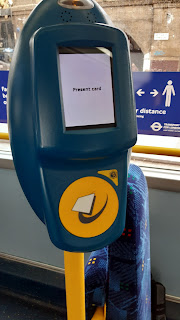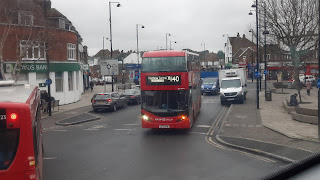10 Interesting and Unique Bus Facts
-
Boarding from the middle door of a London bus used to be quite common (especially in central London) but the number of routes where this is allowed has now decreased substantially to two. They are, in fact, both of the remaining red arrows routes the 507 and 521. The former of these routes runs from London Waterloo Station to London Victoria Station and the 521 runs from London Waterloo Station to London Bridge Station.
Before the pandemic these bus routes ran incredibly frequently (especially in the morning and evening peaks) with a bus every 2-3 minutes. With the single deck electric buses having most of the front seats removed for standing space to increase their capacity.
To facilitate middle door boarding as well as front door boarding extra Oyster Pads are added in the middle of the vehicle
-
The 246 runs to Chartwell only once an hour on Sundays in Summer between about nine and five. Chartwell was Winston Churchill's family home and is located in Kent but as the usual terminus of the 246 at Westerham is only two and a half miles away it is extended to Chartwell to give regular public transport to this historic location.

A 246 at Chatwell terminating at Bromley North Being quite far south of Greater London, a similar distance outside the M25 and a long way from the suburbs the terminus at Chartwell is actually highly rural with the proximal area a magnificent forest which is interspersed with large old houses and their associated farms.
-
Exactly 22 TfL operated bus routes have four characters with 21 of these being night buses such as the aforementioned N279. Mostly these have 4 characters because the routes are usually an extended version of their day time counterparts so take their daytime number.
Intriguingly the N550 and N551 exist but neither the 550 nor 551 exist. You may have noticed that there's one more 4 character bus route which I put as a challenge for you to find.
-
You wouldn't expect a TfL London bus to run along a motorway but the A10 does. On its journey into and out of Heathrow Airport Central the A10 traverses the Heathrow tunnel (like all non flying traffic has to) and then directly joins what is officially the M4 Heathrow Spur to go north. Critically this spur is actually a motorway with its signs in Motorway blue.
Running along a motorway does mean that there are no bus stops in this section and so consequently the A10 is semi express and the fastest way between Heathrow and Uxbridge.
-
London has many night and 24 hour bus routes but only one night bus operates outside Greater London. The N279 operates between Trafalgar Square and Waltham Cross Bus Station with the last half mile of its route out of Greater London.
This is primarily done as it is much more convenient for a bus to terminate at a bus station rather than finding another suitable terminus location just inside Greater London. Which would also need associated infrastructure and the associated costs.
-
Whilst a significant number of buses cross the River Thames, only one goes under the river. This is the 108 which runs between Stratford International and Lewisham via the Blackwall Tunnel.

The tunnel has a 4.00 metre height restriction which means double deck buses are a few centimetres too tall to fit. This is why the 108 operates very frequent, long wheelbase, high capacity single deck buses to cater for demand.
-
The highest numbered TfL operated London bus is the 969. It only runs twice a week in each direction and starts its journey in Whitton. It then travels via Richmond, Mortlake, and Barnes to Roehampton Vale ASDA. The bus then reverses its journey terminating back at Whitton.

The 969 by only running twice a week which consequently means a few bus stops are only served twice a week. One of these stops is Mortlake Station which inexplicably has its own bus shelter.
-
Some buses have prefixed letters such as the aforementioned A10. Most of these letters represent the area served in some way with all the K prefixed buses serving Kingston and all the U prefixed buses serving Uxbridge.

Prefixed buses usually serve a local area so are almost never 24 hour buses, that is except the EL1. The EL in EL1, EL2, and EL3 stands for East London with the EL1 running between Ilford via Barking to Barking Riverside. Prior to the opening of Barking Riverside Overground Station, Barking Riverside was a very isolated place in terms of Public Transport so a very frequent and extensive bus network was created including the EL1 which runs 24 hours a day every day.
-
The shortest TfL operated bus route takes just five or six minutes to complete its full length. The 631 school bus runs between Golders Green Station and Henrietta Barnett School a distance of just two kilometres. Because it is a school bus the 631 only operates between 07:50 and 08:35 (08:20 and 08:55 on Wednesday) towards the school and somewhat unusually in both directions in the afternoon between 15:10 and 16:06. The 631 only runs between Monday and Friday on school days.
-
The straightest TfL operated bus route is most likely the 32 which runs from Edgware along the very straight A5 to Kilburn Park Station. Both Edgware and Kilburn Park are only a couple hundred metres away from the A5 and very few roads are as straight as the A5 which is why the 32 takes this crown.

But a straight bus route doesn’t necessarily mean a fast bus route as the A5 is heavily loaded with traffic and the 32 had an average speed of 8.1 miles per hour (according to the most recent month in bus speed data). In fact the daytime operating bus with the greatest average speed is the aforementioned 246 of 17.4 miles per hour (according to the most recent month in bus speed data).

|
| A mid bus card reader |


.jpg)
|
| The A10 runs on the M4 |


Comments
Post a Comment